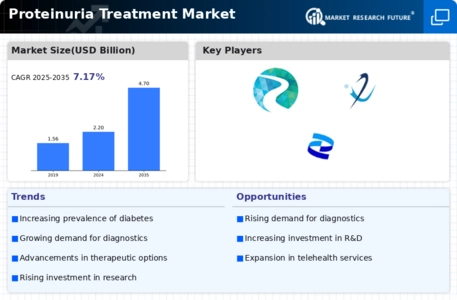Proteinuria Treatment Size
Proteinuria Treatment Market Growth Projections and Opportunities
Proteinuria Treatment Market size by revenue is anticipated to reach USD 4.11 billion by 2032 at a CAGR of 7.17% during the forecast period. Proteinuria, a condition characterized by abnormal amounts of protein in urine, often indicates underlying kidney dysfunction or other medical conditions. The Proteinuria Treatment Market operates within a dynamic framework influenced by various factors that collectively shape its growth and development. Advancements in nephrology research are critical for determining market dynamics for the proteinuria treatment market. Ongoing research contributes towards a deeper understanding of molecular and cellular mechanisms underlying proteinuria and kidney diseases. Discoveries in renal physiology, biomarkers, and therapeutic targets will result in new treatment plans. The increasing number of people suffering from kidney disorders worldwide is an important factor shaping the dynamics of the Proteinuria Treatment Market. Conditions like Diabetic Nephropathy, glomerulonephritis, and chronic kidney disease (CKD) increase the frequency of occurrence of proteinuria. This eventually influences the market dynamics of treatments for proteinuric patients with evolving treatment approaches. This suggests that precision medicine moves into personalized treatment regimens where a one-size-fits-all approach has no place. Regulatory considerations are also key to the market dynamics of treatments for proteinuric patients. Just like all other drugs or interventions being allowed into clinical practice, access to them depends on approval and regulatory pathways adopted. A lot must be done in this field to ensure safety and efficacy concerning drug interactions, side effects, and patient outcomes. Growing importance placed on personalizing healthcare services related to kidneys significantly determines how market behaves regarding treatments for proteinuric patients Henceforth clinicians working with these patients have been looking forward more tailored therapy approaches due their awareness towards heterogeneous nature of renal disorders The competition between companies dealing with medications against proteinuric patients plays an important role on this market This comes about when companies try differentiate themselves by providing innovative medicines, modes/treatments such as therapeutics among many others that can meet the needs of various proteinuric patients Economic factors also influence market dynamics for treatments of proteinuric patients Gross domestic product (GDP) related variables shape the healthcare spending pattern which in turn influences affordability and accessibility of drugs for treatment of this disorder by individuals or health systems Currency fluctuations may lead to recession-driven budget cutbacks on healthcare, which means that procurement officers should be ready to deal with people who look at the price tags first while purchasing pharmaceuticals.








Leave a Comment